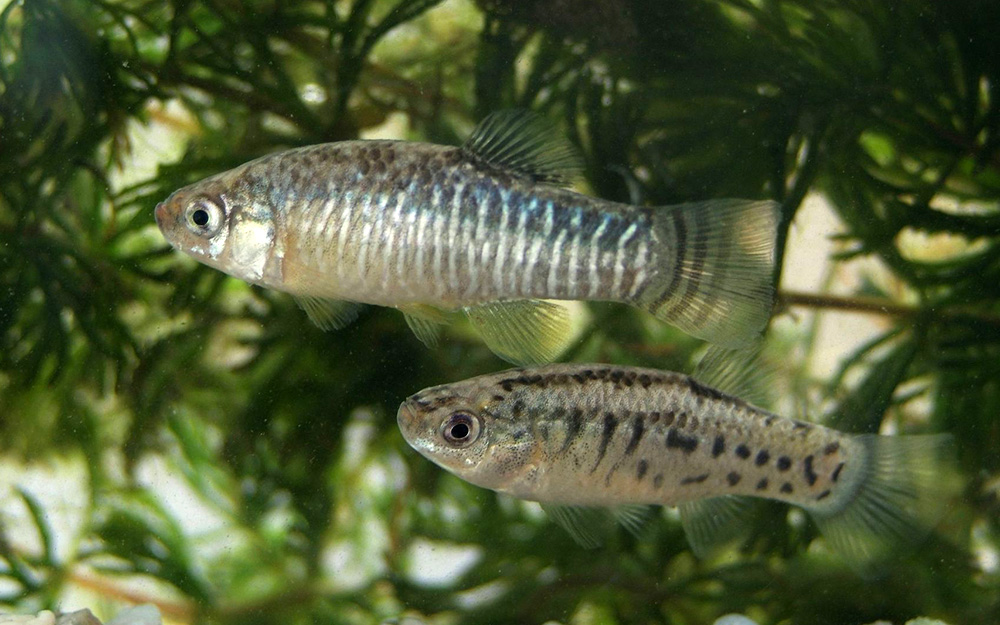Spanish toothcarp
(Apricaphanius iberus)

Classification
This is a small fish, rarely more than 5 centimeters (2.0 in) in length. Females are longer than males of the same age. It has an oblong body and rounded fins. Its dorsal fin is underdeveloped with respect to the fishs girth. It has large scales, numbering 20 to 26 across the body at its widest point.
It has obvious sexual dimorphism. The males are marked with bluish to silver-colored vertical stripes on the flanks and dark bands on the caudal fin. The females are generally greenish-brown with dark blotches distributed irregularly over their bodies; their fins are transparent and mostly unpatterned. Some populations, most notably those in Murcia, have short, dark stripes as opposed to blotches.
The lifespan of a Spanish toothcarp is short. They reach sexual maturity at age three months. The females spawn repeatedly each season, producing from 100 to 900 eggs. Toothcarps in the Murcia region tend to spawn between April and August, while more northerly populations, such as those in the Delta del Ebro, lay their eggs between May and August. Spawning is usually done in areas with nearby vegetation, which shelters the eggs.
Hatchlings emerge approximately eight days after the eggs are laid. Females that hatch in April are able to reproduce in June.
While the females spawn, adult males set up small territories that they defend from other males in ritualized combats through which they court the females.
The Spanish toothcarp is an omnivore, and eats insects, crustaceans, worms and algae. Generally, toothcarps travel in small groups, staying near underwater vegetation, where they normally go unnoticed.
The biology of the Spanish toothcarp is characterized by a high growth rate, early maturity, a high reproductive rate, multiple periods of egg-laying and a short lifespan. From an evolutionary ecology point of view, this lifestyle is highly adaptive for fish that live in unstable environments, such as estuaries, where unpredictable conditions increase mortality. This strategy allows the toothcarp to exploit environmentally favorable conditions during the short intervals in which they occur, thereby revitalizing the population.
Habitat
Spanish toothcarp inhabit shallow, slow-moving bodies of water such as river-mouths, coastal lakes, and ponds. They occur in saline and fresh water alike, due to their ability to tolerate high levels of salinity: they are euryhaline. The Spanish toothcarp can tolerate temperatures of 10–32 °C (50–90 °F), and pH levels between 6.5 and 7.5.
Despite their adaptability, they have been displaced by invasive species, such as both species of mosquitofish, introduced from North America to Spain in 1921 by doctor Sadí de Buen Lozano in an attempt to control malarial mosquitoes. The toothcarp has retreated to high salinity areas where the mosquitofish cannot live.
Distribution
The Spanish toothcarp is characteristic of the Iberian peninsula, and extends from the Aigüamolls of Alt Empordà to Lake Adra in Almería. In the last two decades, the Spanish toothcarp has suffered a severe decline, due in part to destruction of suitable habitats. Only a few dozen isolated populations are known.
They have been found in the alluvial plain of the Segura River, the Chicamo River in Abanilla, the wetlands surrounding the Mar Menor and Valencian Community (more specifically in the Parque Natural de El Hondo, and in the Parque Natural de la Albufera with its springs), the Parque Natural del Delta del Ebro in Tarragona, and the Albufera de Adra and the Adra River.











